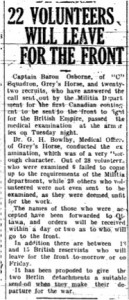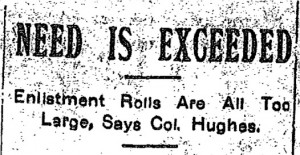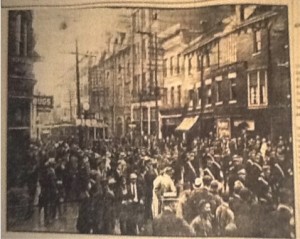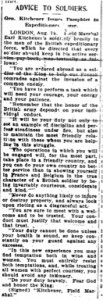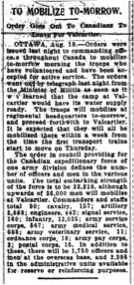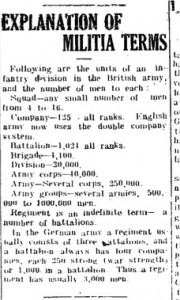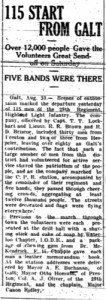Captain B. Osborne and twenty-two members of the “C” squadron, Grey’s Horse, volunteered and were accepted for overseas service. Fourteen of these twenty-two men were Berlin locals, included twelve privates and Sergeant B. Mitchel and Captain B. Osborne. Initially, 28 men had volunteered from the squadron, but only 22 were even granted a medical exam. In addition to these men who volunteered, the region also reported that many British reservists, who resided in the Waterloo Region, were leaving for the front in the initial weeks of August.
Many Canadian men were turned away for lack of military experience or medical reasons, which explains why 63 percent of the First Contingent were British-born men who were either current or former British regulars. Therefore, the high proportion of volunteers with Anglo-Saxon last names, listed in the articles printed in the region, was not necessarily an indication that German-Canadians or other residents of Waterloo region were uninterested in military service and supporting the British Empire. The first contingent’s composition was a reflection of the enlistment requirements set by the Militia Department of Canada.
(“22 Volunteers Will Leave for Front,” Berlin Daily Telegraph, 12 August 1914, “22 Volunteers Will Leave for Front,” Waterloo Chronicle-Telegraph, 13 August 1914, “Berlin’s Volunteers Depart for the Front,” Waterloo Chronicle-Telegraph, 20 August 1914, “Reservists for the Front” Waterloo Chronicle-Telegraph, 20 August 1914; “First Ayr Volunteer,” Ayr News, 20 August 1914; K. Radley, We lead, others follow: First Canadian Division, 1914-1918 (St. Catherine’s, ON: Vanwell Publishing, 2006), 46.)
[1] “22 Volunteers Will Leave for Front,” Waterloo Chronicle-Telegraph, 13 August 1914, p. 10.
